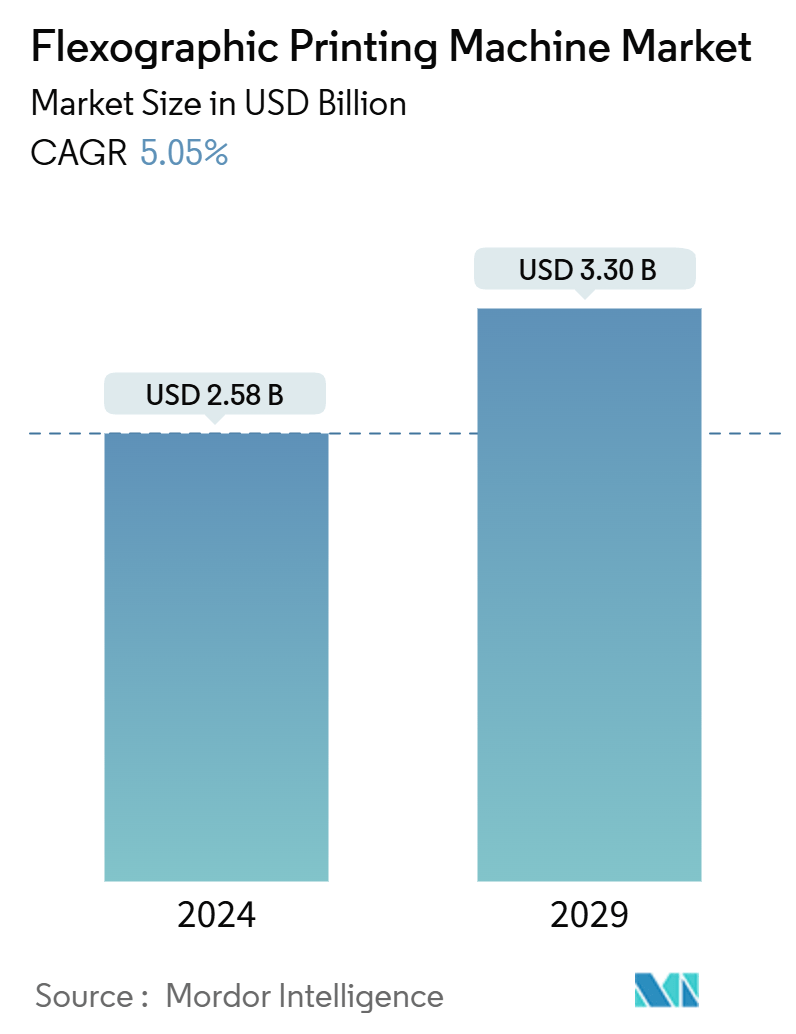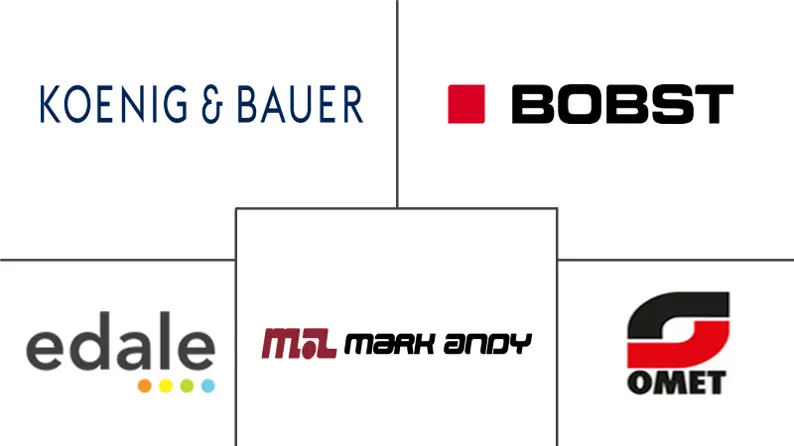Market Size of Flexographic Printing Machine Industry

| Study Period | 2019 - 2029 |
| Market Size (2024) | USD 2.58 Billion |
| Market Size (2029) | USD 3.30 Billion |
| CAGR (2024 - 2029) | 5.05 % |
| Fastest Growing Market | Asia Pacific |
| Largest Market | North America |
| Market Concentration | Low |
Major Players
*Disclaimer: Major Players sorted in no particular order |
Flexographic Printing Market Analysis
The Flexographic Printing Machine Market size is estimated at USD 2.58 billion in 2024, and is expected to reach USD 3.30 billion by 2029, at a CAGR of 5.05% during the forecast period (2024-2029).
- Flexographic printing machinery uses relief plates of flexible rubber or photo-polymer plates, and four rollers such as an ink roller, meter roller, plate cylinder, and impression cylinder. Ink is introduced to an anilox roller that transfers the ink to a flexible, raised-relief image plate wrapped around a cylinder. This cylinder then lays the graphic onto the label paper as it passes through the press at high speed.
- The increasing demand for a printing machine that can be used for a variety of substrates and other products with high versatility and ease of operation, particularly for rather long printing runs on all extensible plastic film, is expected to fuel the adoption of the flexographic printing machines, as the flexographic printing machines can operate at high speeds and its applicability on a different surface and water-based inks as well as oil-based inks.
- Computer-to-plate processes are increasingly used in flexo prepress, enabling machines to reduce prepress times. The process has been extensively used in offset litho. The introduction of flat-top dots in Plates by several vendors has significantly improved print consistency and overall quality.
- As the packaging industry, especially in sectors like food, beverages, and personal care, witnesses rapid growth, the demand for flexographic printing machines has surged. These machines excel in high-speed printing across diverse substrates. Innovations in flexographic printing, including the rise of high-definition (HD) flexo printing and the melding of digital processes, have significantly boosted print quality and efficiency. Such advancements are drawing an increasing number of manufacturers towards adopting flexo systems.
- Moreover, advancements such as AI, machine learning, IoT, and data analytics have significantly personalized offerings. The convergence in flexographic printing enables superior print personalization for large-volume orders. However, the cost factor remains a big hurdle.
- While flexographic printing is anticipated to drive market growth, factors such as the increasing competition from viable alternatives such as digital printing and scanning are expected to challenge the change during the forecast period.
Flexographic Printing Industry Segmentation
A flexographic printing machine is an equipment that can print high-quality prints on various types of flexible materials. It is commonly used in the packaging industry to print labels, tags, packaging materials, and flexible packaging products. Flexographic printing, which uses flexible printed plates made of rubber or photopolymer, is a process that can be used for various purposes, such as printing on any flat surface.
The Flexographic Printing Machine Market is segmented by material (paper, corrugated cardboard, plastic films, metallic films), end-user industry (pharmaceutical, food & beverage, cosmetics, consumer electronics, logistics, print media), and by geography (North America (United States, Canada), Europe (United Kingdom, France, Germany, Italy, Spain), Asia-Pacific (China, Japan, India, Australia) Latin America (Brazil, Argentina, Mexico), The Middle East, and Africa (Saudi Arabia, South Africa, Egypt)). The market sizes and forecasts are provided in terms of value (USD) for all the above segments.
| Material | |
| Paper | |
| Plastic Films | |
| Metallic Films | |
| Corrugated Cardboard |
| End User Industry | |
| Pharmaceutical | |
| Food & Beverage | |
| Cosmetics | |
| Consumer Electronics | |
| Logistics | |
| Print Media |
| Geography | |||||||
| |||||||
| |||||||
| |||||||
| Australia and New Zealand | |||||||
| |||||||
|
Flexographic Printing Machine Market Size Summary
The flexographic printing machine market is poised for significant growth, driven by its versatility and efficiency in printing on various substrates such as plastics, paper, and metallic films. This technology utilizes flexible photopolymer plates and a series of rollers to achieve high-speed printing, making it ideal for long runs and diverse applications. Innovations in prepress and press components, along with advancements in ink technology, have further enhanced the capabilities of flexographic printing machines. The adoption of computer-to-plate processes and flat-top dots has improved print consistency and quality, while the introduction of new technologies like MPS's E-Sleeve has optimized production speeds and cost-efficiency. The market's expansion is also supported by the increasing demand from the food and beverage industry, which favors quick-drying and non-toxic inks for packaging, as well as the growing e-commerce and logistics sectors that require efficient labeling and packaging solutions.
The market landscape is characterized by intense competition among key players such as Koenig & Bauer AG, Mark Andy Inc., and others, who are continually innovating and forming strategic partnerships to strengthen their market presence. The COVID-19 pandemic has highlighted the importance of flexographic printing in sectors like food and pharmaceuticals, although supply chain challenges have impacted raw material procurement. Regulatory developments, particularly in the food and beverage sector, are expected to further drive the adoption of flexographic printing machines. Additionally, government initiatives to boost manufacturing and the rapid growth of the e-commerce industry in regions like India are anticipated to contribute to market growth. Prominent companies are also expanding their offerings through strategic mergers and acquisitions, ensuring a robust competitive environment that fosters technological advancements and market expansion.
Flexographic Printing Machine Market Size - Table of Contents
-
1. MARKET DYNAMICS
-
1.1 Market Overview
-
1.2 Market Driver
-
1.2.1 Rising Need for High Production Speeds
-
-
1.3 Market Restraint
-
1.3.1 Higher Initial Setup Cost
-
-
1.4 Industry Value Chain Chain Analysis
-
1.5 Industry Attractiveness - Porter's Five Force Analysis
-
1.5.1 Threat of New Entrants
-
1.5.2 Bargaining Power of Buyers
-
1.5.3 Bargaining Power of Suppliers
-
1.5.4 Threat of Substitute Products
-
1.5.5 Intensity of Competitive Rivalry
-
-
-
2. MARKET SEGMENTATION
-
2.1 Material
-
2.1.1 Paper
-
2.1.2 Plastic Films
-
2.1.3 Metallic Films
-
2.1.4 Corrugated Cardboard
-
-
2.2 End User Industry
-
2.2.1 Pharmaceutical
-
2.2.2 Food & Beverage
-
2.2.3 Cosmetics
-
2.2.4 Consumer Electronics
-
2.2.5 Logistics
-
2.2.6 Print Media
-
-
2.3 Geography
-
2.3.1 North America
-
2.3.1.1 United States
-
2.3.1.2 Canada
-
-
2.3.2 Europe
-
2.3.2.1 United Kingdom
-
2.3.2.2 Germany
-
2.3.2.3 France
-
2.3.2.4 Italy
-
2.3.2.5 Spain
-
-
2.3.3 Asia
-
2.3.3.1 China
-
2.3.3.2 Japan
-
2.3.3.3 India
-
-
2.3.4 Australia and New Zealand
-
2.3.5 Latin America
-
2.3.5.1 Brazil
-
2.3.5.2 Argentina
-
2.3.5.3 Mexico
-
-
2.3.6 Middle East & Africa
-
2.3.6.1 Saudi Arabia
-
2.3.6.2 South Africa
-
2.3.6.3 Egypt
-
-
-
Flexographic Printing Machine Market Size FAQs
How big is the Flexographic Printing Machine Market?
The Flexographic Printing Machine Market size is expected to reach USD 2.58 billion in 2024 and grow at a CAGR of 5.05% to reach USD 3.30 billion by 2029.
What is the current Flexographic Printing Machine Market size?
In 2024, the Flexographic Printing Machine Market size is expected to reach USD 2.58 billion.

